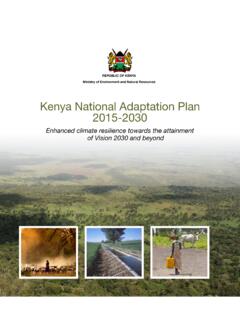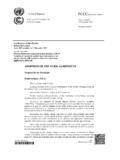Transcription of Accounting for the Effects of Climate Change - GOV.UK
1 Accounting for the Effects of Climate Change Supplementary Green Book Guidance November 2020 Contents Executive 1 Chapter 1: Introduction .. 2 The importance of considering Climate Change .. 3 Key issues to consider when incorporating the impacts of Climate Change into appraisal .. 4 Chapter 2: Approach to Climate resilient appraisal .. 5 Building on the Green Book .. 5 Step one: Developing options .. 7 Step two: Appraisal of options .. 8 Step three: Decision making, Monitoring and 11 Chapter 3: Identifying and Accounting for Climate Change 14 Conducting a risk assessment .. 14 Chapter 4: Developing and refining options under Climate risks and uncertainty.
2 17 Principles of adapting to Climate 18 Approaches to good 19 Designing adaptation interventions .. 22 Chapter 5: Further Appraisal methods under Climate 26 Appraisal methods under Climate uncertainty .. 26 Appraisal in practice .. 31 Annex A: Climate resilient appraisal example .. 32 Annex B: Where to go for further information .. 39 Annex C: UK Climate Projections 2018 (UKCP18) .. 45 Accounting for the Effects of Climate Change 1 Executive summary This supplementary guidance to HM Treasury s Green Book supports analysts and policymakers to ensure, where appropriate, that policies, programmes and projects are resilient to the Effects of Climate Change , and that such Effects are being taken into account when appraising options.
3 This guidance: 1. Builds on the conventional Green Book appraisal methodology to account for the Effects of Climate Change . 2. Supports analysts and policymakers to identify if and how their proposals could be affected by Climate risks and challenges. 3. Supports analysts and policymakers to design adaptation measures in response to Climate risks and challenges. It is important to develop policy and take decisions with an awareness that our Climate is changing. The latest UK Climate Projections 2018 (UKCP18) show an increased chance of warmer, wetter winters, hotter, drier summers, more extreme weather events and rising sea levels. Many policies, programmes and projects will be directly or indirectly affected by a changing Climate and appraisal should account for such impacts, where significant, and respond to them where cost-effective to do so.
4 Otherwise decisions will not necessarily be being based on full understanding of how public value can best be delivered over time. Chapter 1 sets out why it is important to consider the Effects of Climate Change ( ), including examples of key issues to consider when Accounting for the Effects of Climate Change in appraisal ( ). Chapter 2 sets out the principles of Climate resilient appraisal and how it builds on the foundations of the Green Book ( ). It provides an overview of the process for including Climate Change in appraisal ( ) and of appraisal and decision methods under Climate uncertainty ( ). Chapter 3 supports identification of Climate Change risks to policies and proposals using a Climate risk assessment ( ).
5 This includes Accounting for direct and indirect Effects , other important factors and examples. Chapter 4 provides guidance on how to develop policy options in response to Climate challenges, including the principles of good adaptation ( ), approaches to good adaptation ( ) and designing adaptation options ( ). Chapter 5 provides practical guidance on how to perform economic appraisal under Climate uncertainty. This includes guidance on appraisal under uncertainty ( ), Accounting for the Effects of Climate Change 2 incorporating Climate Change risks into the baseline and sensitivity analysis ( ) as well as practical guidance on proportionate Climate resilient appraisal ( ).
6 A Climate resilient appraisal example is provided in Annex A. The guidance also provides useful links for further information on Climate Change adaptation in Annex B. Structure and purpose of each chapter Note: this guidance intends to set out the process for Climate resilient appraisal and provides some detail to support carrying out such appraisal. It may be necessary to seek further detailed guidance on the techniques described. Chapter 1: Introduction Our Climate has already changed and will continue to do so as a result of anthropogenic (man-made) greenhouse gas emissions. Despite international efforts to mitigate further global warming, further Change is locked-in and is unavoidable.
7 Our policies, programmes, investments and plans need to recognise the potential impacts. Where possible and cost-effective, building resilience and adaptation can reduce the impacts of Climate Change . The Climate is changing as the Earth s average temperature rises. The Government has already committed to the goals of the Paris Agreement which aims to hold the increase in global average temperature to well below 2 C above pre-industrial levels and pursue efforts to limit the increase to C1. The Climate Change Act 2008 sets out a policy framework to deliver domestic emissions reductions and to ensure the UK adapts to inevitable Climate 1 The IPCC provides scientific and technical information about how this could be achieved and the impacts and benefits of doing so.
8 See IPCC Summary for Policymakers. In: Global Warming of C. An IPCC Special Report 2018, World Meteorological Organization, Geneva, Switzerland Accounting for the Effects of Climate Change 3 Change . This involves commitments to produce a Climate Change Risk Assessment (CCRA) every 5 years, followed by a National adaptation Programme (NAP) to address those risks. A focus on adaptation has been embedded in other key government commitments such as the 25 Year Environment Plan (25 YEP). This document sets out how to account for the impact of Climate Change in the development, appraisal and evaluation of policies, programmes and projects. It should be read in conjunction with the Green, Orange, Magenta and Aqua Snapshot of Climate Effects : The UK s national Climate projections3 show an increased chance of warmer, wetter winters and hotter, drier summers during the 21st century.
9 Extreme weather events will also become more frequent and sea levels will continue to rise. By the end of the 21st century all areas of the UK are projected to be warmer. By 2070, projections show that the range of average seasonal temperature changes are projected to increase. The temperatures could be between C and C warmer in summer, and C to C warmer in winter. Marine projections indicate that the sea level around the UK will continue to rise until at least 2100 under all future Climate scenarios. The pattern of sea level rise is not uniform across the UK. for Belfast sea level projections suggest an 11-52cm rise in a lower concentration scenario ( ) and 33-94cm rise in a high concentration scenario ( ).
10 In London these correspond to 29-70cm ( ) and 53-115cm ( ). The importance of considering Climate Change Many policies, programmes and projects will be directly or indirectly affected by a changing Climate (reflected in, amongst other things, their effectiveness and costs). It will be particularly important to consider the risks and Effects of Climate Change if a potential policy, programme or project: Has assets or elements affected by the weather and Effects of Climate Change , including variability and extremes: for instance, capital assets such as housing developments, schools, health centres, or other important facilities as well as natural assets such as soils, woodland, peatlands, freshwater or marine and coastal habitats.













